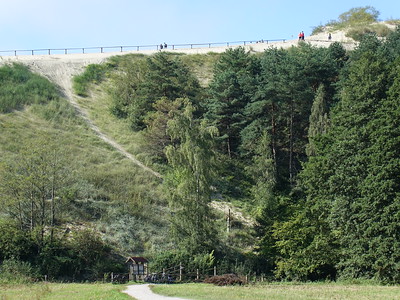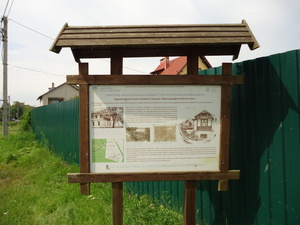Curonian Spit

The Curonian Spit is a narrow sand dune peninsula, preserved from erosion through human efforts since the 19th century.
After earlier settlements were buried by encroaching sand that came to the surface due to logging, the Great Dune Ridge that shapes this land was reinforced with trees and shrubs to prevent it from moving inland. The peninsula still is home to small Curonian lagoon fishing communities and there are archaeological sites such as buried villages to be found.
Community Perspective: most reviewers covered the Lithuanian side: Clyde hiked through the reserve, Jakob did it by bike, and Nan describes the area’s German links. Jarek visited it from the Russian side, which has a pine forest and a bird observation station.

Map of Curonian Spit
Community Reviews
Jarek Pokrzywnicki

As everybody described Lithuanian part of Curonian Spit I will focus on Russian part of this cultural heritage site. Visited in July, 2019, while it was possible to visit Kaliningrad Oblast (Królewiec Area) without Russian visa.
Access from Polish side - border crossing at Grzechotki / Mamonovo - 2 by own car, and then normal transit via Zelenogradsk towards Curonian Spit National Park (Национальный Парк Куршская Коса). Entrance to the park from Russian side is paid - 150 rubles per person and 300 rubles per vehicle. The point where they collect money is located here 54°58'33.0"N 20°31'13.7"E (Kontrol'no-Propusknoy Punkt Natsional'nogo Parka Kurshskaya Kosa, контрольно-пропускной пункт национального парка Куршская коса). The booth is located some 30 meters from the main road, so if you want to buy the ticket to enter the park, you just stop the car on the road (there is no parking space) blocking the passage. There is always a huge traffic jam before the ticket booth in the morning (the queue usually starts at Zelenogradsk - 2-3 km from the booth).
Russian part is pretty similar to Lithuanian one but for me the villages are far less preserved. First on a way, Lesnoy looks like any other Russian village - many new houses built of white bricks. Rybaczij (Rossiten) is a little bit more similar to German towns (some old buildings are still preserved) but overall impression is somehow disappointing. As far as I remember Lithuanian villages are far more better preserved and maintained.
Interesting points on Russian part of Curonian Spit are certainly: Dancing (or Drunk) Forest (Танцующий лес, free entrance) – mystery pine forest where trees are bent to different (natural phenemon of unknown origin – there are different hypothesis, no one is fully proved), Fringilla Bird Observation Station (Биологическая станция "Рыбачий" Зоологического института РАН, Полевой стационар "Фрингилла", as far as I remember entrance fee was around 300 roubles per person, half an hour guiding tour throughout the station - you will see how they catch and ring the birds) and numerous sand dunes located on both sides of the road. In July, 2019, area around Lebed Ozero (Swan Lake) was closed due to conservation reasons.
Practilities: I stayed overnight in Rybaczij at Усадьба "В камышах" (officially translated as Manor "The reeds", 55°09'07.3"N 20°51'27.2"E), nice place, modern building but with some style. In the village there are several shops (on the main street - ulitsa Pobedy) as well as some restaurants.
Photos: top left, then clockwise, Sand dunes, Fringilla Bird Station, Dancing Forest, Old School at Rossiten
Jakob Frenzel

August 2017 - after visiting Latvia, unfortunately just the Western part with Riga. We stayed overnight in a nationalpark Not far from Klaipeda. Next morning we parked our car in Klaipeda, grabbed our folding bikes, took the ferry over and the bus to Nida. The bus took a while and all you could see lot of forests.
Finally we arrived in Nida and had early lunch in one of the cute fishermans houses. Also in Nida we visited the house of Thomas Mann situated on a hill. From there a bikepath back to the ferry would Lead us 50 km north. What an adventure! To allow some stopovers, we had to Pedal quite fast. We drove through wonderful smelling pine forests. Had 2 longer breaks to take a swim in the baltic and took the hike on top of a dune, which is among europes largests. I can recommend to everybody taking the bike. It is a wonderful dayfilling bikeride and the best way to get the essence of this whs.
Nan

Before World War 2 the Baltics had a substantial German population. Germany proper extended all the way to East Prussia with its capital Königsberg. But many Germans also settled further North in the Baltic states. Indeed, most places in the Baltics also have historic German names (e.g. Reval for Tallinn). And plenty of historic figures were of German ancestry. Take our beloved Struve Arcs. Struve was German and taught at was then a German university in Tartu/Dorpat.
As such, travelling the area you will meet plenty of Germans trying to connect to their ancestors. The Curonian Split features quite heavily in these itineraries as it was a prime travel destination of the locals; and still is.
The Split itself is arguably man made. The Prussians intervened to stabilize the dunes and protect it against the sea. It is this engineering feat for which the site was inscribed. Personally, I enjoyed hiking the woods, the beeches and the dunes, but felt a bit hard pressed to pin point the OUV.
Apart from the beeches Nida nowadays boasts two main attractions:
- The old wooden tourist houses in the city center. The most prominent one used to belong to Thomas Mann.
- The big Parnidis dune South of the city.
Getting There and Around
Thanks to Air Baltic plenty of locations in the Baltics are within reach and budget. Only caveat is that you will have to transfer at Riga. I flew via Riga to Palanga and took a bus to Klaipeda from there. The next day I took a morning bus from Klaipeda to Nida on the Curonian Split.
I mostly stayed in and around Nida. I later learnt that you can do one way bike rentals to ride along the coast. The Curonian Split is too long to do it simply by walking.
Getting to the Russian side meanwhile entails getting a visa. Looking across the border it seemed to be the far quieter side.
While You Are There
Klaipeda (German Memel) used to be the Northern most German city and part of the Hanseatic League. Most of the old town was destroyed during World War 2. You can still find glimpses. Due to the German heritage you will meet plenty of German tour groups, primarily consisting of retirees.
From Klaipeda you can travel on to Vilnius via Kaunas (T) or North to Riga.
Clyde

I visited this WHS in August 2016. I based myself in Nida for 2 nights just opposite the Horn of Bulvikis, the widest point of the spit (3.8km). Just next to my timber guesthouse serving delicious savoury blinis for breakfast, there was a pyramid marble structure with the UNESCO inscription plaque engraved on it. From there I followed the 1.7km Parnidis self-guided path in the Neringa National Park. The highest point of this path is the 52m Parnidis Dune and sundial. The panoramic view of Nida and the rest of the Curonian Spit from there is beautiful especially at sunset and sunrise (when no tour buses are around). Since I had more time to spend, I decided to hike towards the protected nature reserve with several shrubs, flowers, plants and trees growing on the sand dunes. The landscape is quite surreal there and the peace and quiet priceless. Small passerine birds and sea birds thrive on this undisturbed stretch of the spit. There are fenced off areas towards the forests to prevent direct access to the Russian border, however if you carry enough water and keep on walking along the dunes closest to the lagoon there is a clear path which will actually lead you to the Russian part of the Curonian Spit. I walked at least 10km as the sundial and viewpoint were not visible any longer and I could clearly see the Baltic sea on the Russian side. Suddenly, as I caught sight of a Russian watchtower, I received a Welcome to Russia text message informing me that I was actually on 'Russian sand'. Happy that I technically visited both sides of this transnational WHS but at the same time feeling uneasy that I was probably trespassing without a visa, I hurried back to the Lithuanian side of the spit and on the way stopped to admire sunset next to a number of crosses and prayer flags in the sand which reminded me of the crosses placed by pilgrims along the route towards Santiago de Compostela in Spain. The next day I visited Nida with its old cemetery with different wooden crosses and the colourful weathercocks. The ferry service to and from the spit is very frequent and efficient and having your own car will help you enjoy both the lagoon area as well as the stretches of sandy beaches by the Baltic Sea.
Els Slots

The Curonian Spit always has been a bit of an enigma to me. Who were these Curonians? And what is a Spit anyway? The Dutch translation (‘Schoorwal’) did not really help me as it is also a very uncommon word, used primarily to address the Curonian Spit. So I was happy that we decided to have our WH meeting in Vilnius this year: with a few extra days I could check out this WHS too. I stayed for two nights in Klaipéda, the easiest access point to the Lithuanian part of the Curonian Spit.
Besides its name, another part of the site’s mystery is why it was designated a WHS. It was put forward under 7 natural and cultural criteria. But in the end, it was only recognized for one: the efforts, started by the Prussians in the 19th century and continued by the Lithuanian and Russian authorities after WWII, to save this sand dune peninsula from erosion. Constantly moving sand dunes even had made whole villages disappear. Large-scale (re)afforestation was started to keep the sand in place.
Forest still is one of its main features: my first impression of the peninsula was driving by bus from Smitylne to Nida. Especially the first half-hour or so goes on a narrow road through a dense forest. The Lithuanian road ends after 50km in the town of Nida, close to the Russian border which unfortunately cannot be crossed easily (one needs a Russian visa and a mode of transport). Nida is the site of the Spit’s no. 1 landmark: the Parnidis Dune. That’s where I headed for my first hour of exploration.
It’s a fine walk, with the bonus of a bit of warm sand between your toes. The scenery reminded me of the islands in the Dutch part of the Wadden Sea, the most comparable WHS to this one. The Curonian Spit also shares the nuisance of high visitor numbers in a relatively confined space with it. Lots of families with young children were trodding along on the interpretative trail to the Parnidis Dune. And at the top it got even worse: there is a bus parking at the back. Literally, hundreds of cruise ship passengers are offloaded from their buses all day long, to be allowed a glimpse of this work of nature too.
Back in the village of Nida I visited an old fisherman’s house. It is a reminder of the life of the Curonians, who lived in this region until they merged with other Baltic tribes in the 16th century. Via a video display, you can witness the last two men speaking the now extinct Curonian language. Next to the house is an exhibition of colourful Curonian weathervanes. Sculpted from wood, they were not only useful for the sailors to see which way the wind was blowing but also indicated the people ashore from which hamlet they came.
For lunch, I had put my sights on the local specialty: smoked fish. For 5 EUR I got a large smoked mackerel on a paper plate, which I enjoyed dissecting. With this boost of energy, I walked to the other end of Nida, where I had a look at the old cemetery. The graves here are specifically mentioned in the AB evaluation, so this is an aspect not to be missed. The gravemarkers are cut from timber into designs of flowers or human silhouettes. It’s not exactly that the cemetery is full of them, but I found a few.
On my way back to the ferry to Klaipéda I made a stop in Juodkranté, the second most important town on the peninsula. It is a historic seaside resort, with lots of early 20th-century wooden villas. It also is home to the 'Hill of Witches', where artists have shown their woodcarving skills via timber sculptures depicting local legends. It's a bit of a tourist trap, but some are nicely done and it is a fine short hike through yet another part of the forest.
Jon Sharp
I am married to a Lithuanian lady ,we go there regually to visit her family. On one such visit we holidayed in Nida on the Curonian Spit.As an Englishman I have never seen the like in England.You sit down for breakfast in a modernish restaurant then take a walk for about a mile and you have gone back 200 years in time. For me the most peaceful and tranquil place on earth.
Christer Sundberg

The Coronian Spit is a 100 km long and 1-4 km wide sand dune peninsula in the south-east of the Baltic Sea, shared between Lithuania and the Russian enclave of Kaliningrad. On the western side of the peninsula you face the Baltic Sea and on the east side - the “inside” – there is a large lagoon. Just where the tip of the spit forms a narrow sound against the land, Klaipeda, Lithuanias major port is located. Or “Memel” as the town was known up until the end of WWII when then the population was predominantly German. Today it is 100% Lithuanian.
I arrived to Klaipeda on a bright summer day, after having crossed the Baltic Sea from Sweden on a pleasant overnight cruise. Klaipeda was badly damaged during WWII but still have enough old buildings and charm to be a major tourist destination. Later jumping across the sound between Klaipeda to the Spit takes about 10 minutes with a small ferry that runs back and forth all day. On the Spit, buses are running up and down and 45 minutes later I found myself in the small village of Nida, close to the Russian border. It is in Nida you will find the famous Paradise Dunes, massive sand dunes which equals you probably have to go to Sahara to find.
Walking on the sea side of the Coronian Spit was a peculiar experience. The sun was shining from a hot, clear blue summer sky and yet there was not a person in sight on this never-ending sandy beach. It was quite an amazing feeling to be completely alone in a place where - in our overpopulated world – you would normally find hundreds of people, lazing in the sun.
Klaipeda and the Coronian Spit is a perfect – yet not discovered - holiday destination for those with children and family. Klaipeda offers numerous nice restaurants and on the Spit it’s just to choose whether you want to dip your toe in the Baltic Sea or in the lagoon…
Community Rating
- : BobSmithseestheworld SirLoydd Hurrvinek Disnsam Christoph Caminographer
- : CyBeRr Luki501 Cmtcosta Roman Raab CugelVance Flexiear
- : Tarquinio_Superbo Szucs Tamas Eric Lurio Filippo Ubaldi Eva Kisgyorgy Stanislaw Warwas Jakob Frenzel Tony H. Astraftis Javier Alexandrcfif Dhhtravel Cezar Grozavu ZiemowitFilip ChrisDorn JobStopar Krijn Rafał Kałczuga
- : Philipp Peterer Thibault Magnien Michael anak Kenyalang Christravelblog Feldhase JoStof Ivan Rucek Els Slots
- : Csaba Nováczky Kristin Peter Lööv Hubert Svein Elias Gary Arndt Martina Rúčková Don Irwin Argo Clyde Kevin247 Carlos Sotelo
- : Alexander Lehmann Randi Thomsen Wojciech Fedoruk Shandos Cleaver Philipp Leu Zoë Sheng Dorejd Craig Harder Tevity Luboang Juha Sjoeblom
- : Nan Squiffy Lucio Gorla David Berlanda George Gdanski
- : Solivagant
Site Info
- Full Name
- Curonian Spit
- Unesco ID
- 994
- Country
- Lithuania Russia
- Inscribed
- 2000
- Type
- Cultural
- Criteria
-
5
- Categories
- Cultural Landscape - Continuing
- Link
- By ID
Site History
2000 Rejected
Rejected for natural criteria: 'only' important at the European scale
2000 Inscribed
Site Links
Unesco Website
Official Website
Related
In the News
Locations
The site has 1 locations
The Lithuanian part can easily be visited by one of the hourly ferries from Klaipéda. It takes just 5 minutes to cross the lagoon, and a bus will be waiting to take you further inland.
Connections
The site has 32 connections
Art and Architecture
Constructions
Damaged
Ecology
Geography
History
Human Activity
Individual People
Religion and Belief
Timeline
Trivia
World Heritage Process
Visitors
228 Community Members have visited.
The Plaque
 (photo by Jarek)
(photo by Jarek)